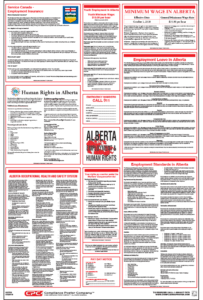 We all knew it was coming, but some employers may still be surprised to find that it’s already here: Alberta’s Fair and Family-friendly Workplaces Act is now in effect. The Act, which passed the Legislative Assembly in June of 2017, represents the first update to the Employment Standards Code in nearly 30 years.
We all knew it was coming, but some employers may still be surprised to find that it’s already here: Alberta’s Fair and Family-friendly Workplaces Act is now in effect. The Act, which passed the Legislative Assembly in June of 2017, represents the first update to the Employment Standards Code in nearly 30 years.
The process started in April of 2017 when the Alberta Ministry of Labor put out a call for comments on the Code, which establishes the minimum standards for employment relationships under provincial jurisdiction. Of particular interest to the Ministry was how Albertan workers felt they stacked up to other provinces in terms of job-protected leave.
Before the new law, eligible employees were entitled to take job-protected maternity leave, parental leave, compassionate care leave (for the care of a gravely-ill family member), and reservist leave (for the purposes of annual training or deployment). With the exception of reservist leave, employees did not become eligible for job-protected leave until after 12 months of employment.
Fair and Family-Friendly Workplaces for Alberta
In an effort to modernize and measure up to employment standards offered by other provinces, the Fair and Family-friendly Workplaces Act makes significant changes to the Employment Standards Code. The most celebrated – and most comprehensive – changes are to job-protected employment leave.
In addition to reducing the eligibility period for most types of leave to 90 days of employment, the Act extends the maximum leave periods for maternity, parental, and compassionate care leave. Further, it allows employees to become eligible for the following types of job-protected leave:
- Long-term injury and illness leave
- Personal and family responsibility leave
- Bereavement leave
- Domestic violence leave
- Citizenship ceremony leave
- Critical illness leave (for an adult or child family member)
- Death or disappearance of a child
Employers will also have to reexamine policies surrounding general holidays and holiday pay. Employees are now eligible for holiday pay as soon as they start employment, rather than after 12 months, and they must receive holiday pay regardless of whether the holiday falls on a regular day of work for the employee.
The Act also eliminates the exemption which allowed workers with disabilities to be paid less than the general minimum wage in some circumstances, and clarifies some aspects of the law which were previously ambiguous. For example, the Act specifies that employees are entitled to “at least 30 minutes of rest, whether paid or unpaid, within every 5 consecutive hours of work.” The Code previously stated that employees were entitled to the rest period “during each shift in excess of 5 hours,” which suggested that the rest period could be given several hours after the first 5 hours of work.
There are additional changes to the standards for overtime agreements (in regards to banked overtime and compressed work week arrangements) and some aspects of employment termination requirements. The majority of changes went into effect on January 1, 2018, but rules governing youth employment do not become effective until May 1, 2018. For a comprehensive overview of changes, see Alberta’s Employment Standards Code changes summary here.
The New Alberta Labour Law Poster
 Although Alberta does not mandate the posting of American-style informational notices, many employers prefer to display informational posters alongside legally-mandated postings to ensure that employees are fully informed of their rights and responsibilities without having to page through complicated legal text.
Although Alberta does not mandate the posting of American-style informational notices, many employers prefer to display informational posters alongside legally-mandated postings to ensure that employees are fully informed of their rights and responsibilities without having to page through complicated legal text.
For those employers, CPC has created our Alberta All-On-One ™ Labour Law Poster, which comes with two sectioned companion posters to allow employers to easily track and post the copies of laws, regulations, and internal policies which are required under Alberta’s laws. Informational notices and posting reminders are also available as an Alberta Mobile Poster Pak for easy desk reference or mobile work sites.
Due to Alberta’s significant overhaul of the Employment Standards Code, we’ve in turn made significant changes to our Alberta All-On-One ™. We have removed the “Workplace Rights and Responsibilities in Alberta” posting and replaced it with three all-new informational notices:
- Employment Standards in Alberta provides information on pay periods and pay statements, hours of work and rest, overtime, holidays and holiday pay, vacations and vacation pay, and termination of employment.
- Employment Leave in Alberta provides brief information on the 11 types of employment leave that employees may be eligible for, including the intended uses of leave, the maximum allowable leave period, and whether leave may be taken in non-consecutive periods.
- Youth Employment in Alberta provides information on the requirements for employing for those in the 12-14 age group and the 15-17 age group. These standards will remain in effect until May of 2018, so expect changes later this year.
We’ve also made important revisions to the following notices:
- Minimum Wage in Alberta has been updated with information on the new deduction standards and clarification that the minimum wage now applies to people with disabilities.
- Human Rights in Alberta has been revised to reflect a recent amendment to the Human Rights Act which makes age a protected ground in the areas of goods, services, public accommodation, and tenancy.
- Your Rights under the Workers’ Compensation Act has been updated with the new URL for filing an online report of injury.
Upcoming Changes
In December of 2017, the Alberta Legislature passed An Act to Protect the Health and Well-being of Working Albertans to improve the province’s workers’ compensation and occupational health and safety (OHS) systems. While changes to the Workers’ Compensation Board went into effect on January 1, 2018, OHS amendments do not take effect until June 2018. We will be reviewing these changes over the upcoming months to ensure that Alberta Labour Law Posters remain up-to-date.
To keep up with labor law news and poster updates for Canada or the U.S., subscribe to our blog or follow us on Facebook and Twitter. You can also contact a Compliance Advisor by chat or phone for assistance with your unique posting needs.

